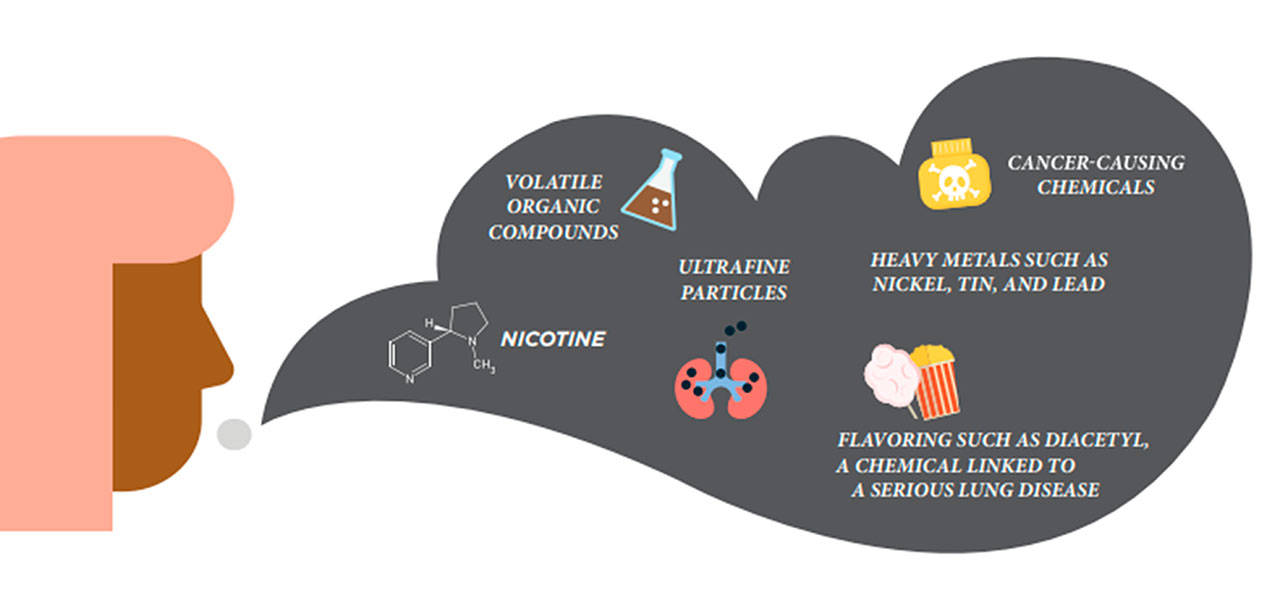The following is written by Carley Thompson for Public Health Insider:
Part Three: Over the next few weeks, in a three-part series of blog posts, we’ll take a deeper dive into the JUULing and vaping epidemic among youth in King County and across the country. We’ll look at what youth are doing in King County, what parents can do to help keep their kids tobacco-free, and how e-cigarette use can lead youth to a lifetime of nicotine dependence. Read Part One and Part Two.
With the youth vaping epidemic sweeping the country (the culprit, JUULs, have you heard of them?)scientists, researchers, and public health advocates have been taking a look at how vaping really affects youth and their health (parents, you can help too).
Here’s what we know: Tobacco use among youth and young adults in any form, including e-cigarettes, is not safe.
YOUTH ARE MORE VULNERABLE TO ADDICTION
Nicotine is a highly addictive substance. A single JUUL pod (a cartridge of vape liquid) contains as much nicotine as a pack of cigarettes, or 200 cigarette puffs. This powerful nicotine punch is putting a new generation of youth at risk for nicotine dependence. Nicotine during adolescence and young adulthood can have long-term negative impacts on brain development and can cause addiction.
Compared with older adults, the brains of youth and young adults (which are still developing until age 25) are more vulnerable to the negative consequences of nicotine exposure. The effects of nicotine on the developing brain include reduced impulse control, deficits in attention and cognition, mood disorders, and addiction.
Because addiction is a form of learning (which happens at an accelerated rate during brain development) youth and young adults can get addicted to nicotine more easily than adults. The nicotine in e-cigarettes and other tobacco products can even train your brain to be more easily addicted to other drugs like meth and cocaine.
IT’S NOT JUST WATER VAPOR
Many teens think vaping isn’t that harmful and that e-cigarettes just contain water vapor. But, that isn’t the case. Although e-cigarettes generally emit fewer toxins than combustible tobacco products, we know, according to a recent report from the U.S Surgeon General, e-cigarette aerosol is not harmless water vapor. It can expose users to several chemicals, including nicotine, carbonyl compounds, and volatile organic compounds (such as benzene, which is found in car exhaust), which are known to have adverse health effects. Flavorants in vape liquid can also be harmful to your health. Diacetyl, the flavoring chemical in some e-cigs, gives food a buttery taste. But, when inhaled, it is linked to a serious lung disease called “popcorn lung.” Researchers found diacetyl in 75% of the vape liquid they tested. If that’s not enough, heating vape liquid can produce dangerous byproducts, including heavy metals like lead, tin, aluminum, and nickel, all of which is inhaled.
While the U.S Food and Drug Administration (FDA) has authority over the manufacturing of vape products that contain nicotine, there is no oversight in what goes into the products that claim to be non-nicotine. It may be years before the FDA considers regulating chemicals used in vape products.
GATEWAY TO LIFELONG TOBACCO USE
Tobacco use is still the leading cause of preventable disease, disability, and death in the United States. Young adults who use e-cigarettes are more than four times as likely to begin smoking tobacco cigarettes within 18 months as their peers who do not vape, and nearly all habitual tobacco use begins during youth and young adulthood. According to the Centers for Disease Control and Prevention, e-cigarette use among youth and young adults is strongly linked to the use of other tobacco products, such as regular cigarettes, cigars, hookah, and smokeless tobacco. Preventing youth from vaping can help a whole generation avoid a lifetime of nicotine dependence.
WE NEED TO KNOW MORE
Though we know that aerosol from e-cigarettes is not harmless. The health effects and potentially harmful doses of heated and aerosolized e-liquids, including solvents, flavorants, and toxins, are not completely understood. Scientists are still working to understand more fully the health effects of e-liquids, both when they are heated and when they are turned into an aerosol.
Gaps in scientific evidence exist, and the e-cigarette market and vaping products are changing rapidly. We need long-term research to fully understand the effects of vaping on our health and the health of youth.


